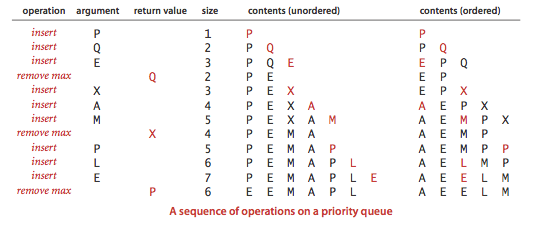

This method returns an array containing all of the elements in this queue. This method returns the number of elements in this collection. This method removes a single instance of the specified element from this queue, if it is present. This method retrieves and removes the head of this queue, or returns null if this queue is empty. This method retrieves, but does not remove, the head of this queue, or returns null if this queue is empty. This method returns an iterator over the elements in this queue. This method returns true if this queue contains the specified element. This method returns the comparator used to order the elements in this queue, or null if this queue is sorted according to the natural ordering of its elements. This method removes all of the elements from this priority queue. This method inserts the specified element into this priority queue. This creates a PriorityQueue containing the elements in the specified sorted set. This creates a PriorityQueue containing the elements in the specified priority queue. This creates a PriorityQueue with the specified initial capacity that orders its elements according to the specified comparator. PriorityQueue(int initialCapacity, Comparator comparator) This creates a PriorityQueue with the specified initial capacity that orders its elements according to their natural ordering. This creates a PriorityQueue containing the elements in the specified collection.

This creates a PriorityQueue with the default initial capacity (11) that orders its elements according to their natural ordering. The elements of the priority queue are ordered according to their natural ordering, or by a Comparator provided at queue construction time, depending on which constructor is used.Ī priority queue does not permit null elements.Ī priority queue relying on natural ordering also does not permit insertion of non-comparable objects.įollowing is the declaration for class −įollowing is the parameter for class −Į − This is the type of elements held in this collection.
#Declare priority queue java how to
In this article, you learned what a priority queue is, how to utilize one, how to create one with a custom comparator, and how to include user-defined objects in a priority queue.The class is an unbounded priority queue based on a priority heap.Following are the important points about PriorityQueue − toArray returns the array equivalent of PriorityQueue () Use contains to see if an element is present in PriorityQueue ()īoolean ret_val = ntains("Five") Removing 'five' using the method remove () ("\n\nAfter removing an element" + "with poll function:") ("Head element is using the peek method:" + numPQ.peek()) Print the head element using Peek () method PriorityQueue numPQ = new PriorityQueue() Heaps, unlike Binary Search Trees, do not keep absolute left-to-right ordering. For example, in a max-heap, parents are always greater than their children. As previously stated, binary heap only guarantees semi-ordering: elements in upper nodes are more (or fewer) than those in lower nodes. As you can see above, the items are not saved in sorted order. The components were then printed once I iterated over the queue. We added a few integers to the queue in any order in the example above. Let's go over the elements one by one to see if they're all stored in the same order. Public class CodePriorityQueueCustomComparator After adding the integers to the priority queue, we’ll remove them to notice how the smallest integer gets deleted first, then the next smallest integer, and so on. Let’s construct an integer Priority Queue and add some integers to it.


Because PriorityQueue isn’t thread-safe, Java provides a workaround.If there are numerous components tied for the lowest value, the head is one of the – ties broken at random. The Java Queue interface is a subtype of the Java Collection interface. This is similar to how a queue in a supermarket works. The last entry in the specified ordering is at the head of this queue. The Java Queue interface, represents a data structure designed to have elements inserted at the end of the queue, and elements removed from the beginning of the queue.We can’t establish a PriorityQueue of non-comparable objects.The following are some key factors to remember about Priority Queue: Reverse an array in Java explained with examples


 0 kommentar(er)
0 kommentar(er)
